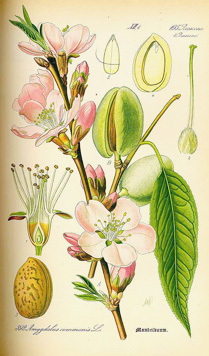Almond Joys
By Audrey Stallsmith

The Hope, in dreams of a happier hour
That alights on misery’s brow
Springs out of the silvery almond flower,
That blooms on a leafless bough.
"Lalla Rookh" by Thomas Moore
The Danes often serve a rice pudding called risalamande for Christmas with a whole almond buried somewhere in the middle. Whichever person finds it supposedly is assured of good luck for the coming year. That sounds similar to the British tradition of adding a silver sixpence to a plum pudding.
With my luck, I probably would break a tooth on either the almond or coin, thus canceling out my good fortune! In fact, my dentist already accuses me of “chewing on rocks,” since I like eating mixed nuts for a nutritious snack during mid-afternoon.
One of those is the sweet almond (Prunus dulcis var. dulcis or Amygdalus communis), its common name deriving from the Latin amandela, which long has been considered a symbol of fertility and good fortune. The Romans showered newlyweds with the nuts, which must have been considerably more painful than a rain of rice!
The almond also could be a sign of God’s blessing. As you may recall, when the Israelites were choosing a priest in the Old Testament (Numbers 17), Moses had each of the tribal chiefs bring him a wooden rod. Those were placed in the inner room of the tabernacle overnight.
When Moses went to "pick up sticks" the next morning, he found that “Aaron’s rod, representing the tribe of Levi, had budded and was blossoming, and had ripe almonds hanging from it!” That is pretty fast work even for almonds which are known as shakad in Hebrew for their “hasty awakening.” In Israel they often bloom as early as late January, before the leaves actually appear on the trees.
For that reason, the almond stands for "indiscretion" (lack of good judgement) in the Language of Flowers, since a smarter tree would wait for more settled weather. As the consumption of almonds once was believed to prevent intoxication, though, we could say that the nut may have prevented some forms of indiscretion!
Shaped to resemble budding almond branches, the tabernacle's golden lampstand served as a not-so-subtle reminder that God had chosen the Levites for the priesthood. By Shakespeare’s time, though, the nut would stand for temptation. Thersites comments in Troilus and Cressida that “Patroclus will give me anything for the intelligence of this whore: the parrot will not do more for an almond than he for a commodious drab [prostitute].”
Almond blossoms can be either pink or white tinged with pink. They are followed by fruits clothed in leathery red-tinged green coats, which eventually crack and allow the nuts to fall out. At that point, they still are enclosed in cream colored shells which usually must be removed before the almonds are marketed, though you can see them "whole" in those bags of unshelled nuts sold during the holidays.
Belonging to the rose family, the almond tree grows 20 to 30 feet tall and originated in Asia and northern Africa. Brought to California by Franciscan priests in the 1700s, it didn’t thrive there until moved inland from the cooler coastal regions.
In addition to their use as a snack or an ingredient in confectionery, almonds are pressed to make sweet almond oil—useful in medicine and cosmetics—and sweet almond milk. The latter has become popular with persons who cannot “stomach” the lactose in genuine milk.
Although the bitter almond (Prunus dulcis var. amara) once was used in cooking and medicine too, especially to expel worms and treat rabies, it can be dangerous since it contains prussic acid (cyanide). So I would stick to the sweet type!
They are supposed to be high in protein, fiber, healthy oils, calcium, magnesium, and some of the B vitamins. Not to mention that nuts fill you up enough that you won’t feel like indulging in more unhealthy snacks.
So maybe these days the almond can represent the relieving of temptation rather than temptation itself. It also can stand for hope, like the dwarf nonfruiting type (Prunus glandulosa) we once had which used to burst into pink, double-flowered bloom in early spring. As Edwin Arnold wrote of “Almond Blossom,” it is
. . .sent to teach us
That the spring days soon will reach us,
Lest with longing, over-tried,
We die as the violets died.
Image of Prunus dulcis var. dulcis is by O.W. Thomé, from Flora von Deutschland Österreich und der Schweiz, courtesy of plantillustrations.org.








